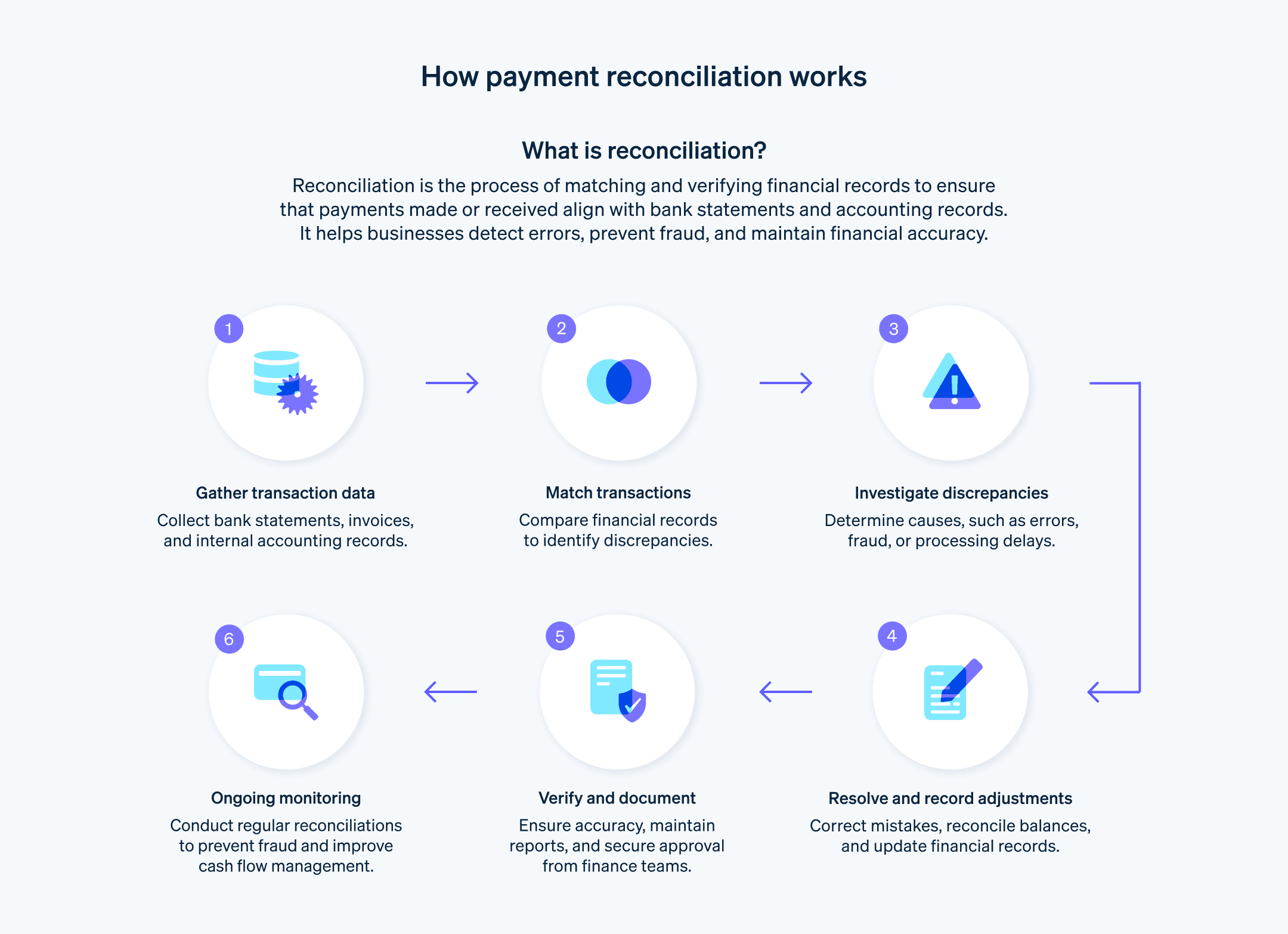根据注册欺诈审查师协会,企业每年因欺诈行为平均损失其年收入的 5%,其中很大一部分可归因于财务记录的不规范。支付对账通过将内部会计记录与银行对账单及交易记录进行核对,在识别和解决这些不规范问题上发挥着关键作用。支付对账在识别和解决这些不规范问题上发挥着关键作用。
除了防止错误和欺诈外,支付对账还有助于做出明智和数据驱动的决策,与客户和合作伙伴建立积极的关系,并遵守法律和财务标准。
本文将全面介绍对账支付的不同方面,剖析其工作机制、最佳实践以及它为企业带来的实际益处。
目录
- 什么是支付对账?
- 支付对账是如何运作的?
- 支付对账的类型
- 为什么支付对账对企业很重要
- 支付对账最佳实践
- 使用 Stripe 进行支付对账
什么是支付对账?
对账支付是一种财务流程,涉及匹配和比较交易记录,以确保所支付或收到的款项与企业会计账簿或财务报表中的记录准确且一致。此过程对于验证财务交易的准确性、避免错误或差异以及维护财务记录的完整性至关重要。
支付对账是如何运作的?
支付对账涉及几个步骤,有助于确保财务报表中记录的付款与已支付或收到的付款。具体流程因企业而异,但通常包括以下步骤:
收集数据
收集所有相关的财务文件和记录,例如银行对账单、账单、收据和会计系统。您将使用此数据来验证付款的准确性。匹配交易
将银行对账单中的记录与会计系统中的条目进行对比。确保交易的日期、金额和描述相匹配。识别差异
在匹配过程中,您可能会发现一些交易无法对应。这些差异可能源于时间差异、错误或欺诈行为。列出这些差异以供进一步调查。解决差异
调查这些差异以确定其原因。这可能涉及联系发卡行,检查原始交易文件或复核会计条目。一旦确定了差异的原因,请在会计记录中做出必要的更正或调整。记录调整
有时,您可能会发现某些交易在会计系统中记录不正确或完全丢失。记录任何为对账所需的调整,如银行手续费、利息收入或更正错误。验证余额
在进行所有调整后,验证会计记录中的调整余额是否与银行对账单上的期末余额相符。记录流程
保留对账流程的记录,包括任何差异和调整。这些文档对于审计目的以及确保问责制和透明度至关重要。审查和批准
根据您组织的规模和结构,可能需要主管或经理审核并批准对账支付流程,以确保其正确执行。
对账支付通常定期进行,如每月或每季度。

支付对账的类型
特定的交易或记录需要不同类型的支付对账。例如:
银行对账
银行对账涉及将公司现金账户中记录的交易与银行对账单上显示的交易进行匹配。企业通过银行对账来确保会计记录中的现金余额与银行报告的余额一致。信用卡对账
信用卡对账与银行对账类似,但专门针对信用卡账户。它涉及将会计系统中记录的交易与信用卡对账单进行匹配,以确保准确性,并检测任何未经授权或欺诈性交易。应收账款对账
应收账款对账是指将客户的付款和贷项通知单与所开账单进行核对。它有助于企业确保客户付款记录的准确性,并使其能够识别和解决任何差异,如少付款或多付款。应付账款对账
应付账款对账是指将供应商账单、贷项通知单和已付款项与应付账款账簿中的记录进行匹配的过程。它有助于确保企业正确支付员工薪资,并以适当的方式核算薪资税和其他扣款。公司间对账
对于有多个子公司或部门的企业而言,公司内部对账涉及对同一企业集团内不同实体之间发生的交易进行核对和协调。这确保了企业在不同实体之间记录公司内部交易时保持一致性。薪资对账
薪资对账涉及通过比较薪资记录与银行对账单和其他支持性文件,来验证薪资交易的准确性,包括工资、扣款和税款。它有助于确保企业正确支付员工薪酬,并以适当的方式核算薪资税和其他扣款。总分类账对账
总分类账对账是一种更广泛的对账类型,可以涵盖上述几种类型中的几种。在总分类账对账中,企业将总账中的各个账户与相应的明细账或支持文件进行核对。这确保了所有交易都在总账中准确记录。
每种类型的支付对账都有其特定的目的,并且对于维护财务记录的准确性和完整性都非常重要。您使用的具体对账类型将取决于与您的业务性质和处理的交易类型相关的多种因素。
为什么支付对账对企业很重要
对于任何企业而言,财务准确性和责任性都至关重要。但是,企业每天处理的大量交易使金融环境变得复杂。支付对账是应对这种复杂性的重要工具。它就像指南针一样,引导企业验证财务记录的准确性,确保合规性,并做出明智的决策。以下是支付对账对企业如此重要的几个关键原因:
检测错误和差异
通过支付对账,企业可以精确找出会计记录与实际交易之间的错误或差异。这些错误和差异可能从轻微的数据录入错误到更严重的问题(如遗漏交易)不等。预防欺诈
定期账户对账起到了一种保障作用,有助于企业发现未经授权的交易或不规则情况,这可能预示着欺诈行为。及早发现这些问题对于控制损害是必要的。改善现金流管理
支付对账可帮助企业了解其真实的现金状况。在准确了解手头现金的基础上,企业可以就投资、支出和债务管理做出明智的决策。确保准确的财务报告
对账过程确保了财务报表能够反映企业的财务状况。这种准确性不仅对内部决策至关重要,而且对于与投资者、债权人和监管机构进行透明沟通也至关重要。遵守法律法规
定期的支付对账在确保遵守法律和监管要求方面发挥着关键作用,从而降低了受到处罚和法律挑战的风险。加强与利益相关者的关系
当财务记录精确且更新及时时,包括投资者、供应商和客户在内的利益相关方更有可能信任该企业。这种信任有助于维持牢固和互利的关系。促进审计
一个组织有序且彻底的对账流程能够简化审计过程。审计师可以有效地审查对账文件和流程,从而减少审计调整或疑虑的可能性。优化运营效率
支付对账可帮助企业突出需要改进流程的领域,例如付款程序或内部控制。对这些领域进行优化可以提高效率并降低成本。支持预算和预测
通过对账获得的准确财务数据对于有效的预算和预测至关重要。它使企业能够做出切合实际的预测,并为未来的财务需求制定计划。
除了保护企业免受错误和可能发生的欺诈之外,支付对账还为基于战略和事实的决策、合规性以及基于信任的利益相关者关系奠定了基础。支付对账对企业当前和未来健康发展的影响不容小觑。
支付对账最佳实践
支付对账是企业的一项基本财务流程。为了使支付对账尽可能有效且高效,企业应采纳以下最佳实践:
定期进行支付对账
企业应定期进行支付对账,通常每月进行一次。定期对账有助于企业及时发现和解决错误和差异。职责分离
为了最大限度地降低错误和欺诈的风险,记录交易的人员不应与对账的人员相同。这种职责分离为企业提供了一种制衡系统。使用对账软件或工具
企业可以使用专门的软件或工具来自动化大部分对账过程。这不仅提高了效率,还最大限度地减少了手动错误,并提供了更好的跟踪和报告功能。标准化对账流程
建立标准化的对账程序可以确保一致性和准确性。记录这些程序,并确保相关员工充分理解并严格遵守。详细记录
保留对账过程的详细记录,包括任何调整的解释。这些记录对于审计和了解交易的历史背景是必要的。及时调查差异
立即调查差异。迅速采取行动对于纠正错误、必要时追回资金以及防止未来出现类似问题至关重要。培训员工
确保所有参与对账过程的员工都接受了适当的培训。他们必须精通会计实践、法规以及如何使用任何适用的对账工具或软件。创建审核和批准流程
应由主管或经理审查和批准对账报告。这一额外的监督层有助于确保对账过程的准确性和完整性。维护安全性和访问控制
仅授权人员可访问财务记录和系统。实施强有力的安全措施以保护敏感的财务信息。衡量进度并追求卓越
定期评估对账过程的效率和有效性。将您的实践与行业标准进行比较,并寻找改进系统的方法。建立清晰的供应商沟通渠道
与银行、供应商和参与金融交易的其他各方保持清晰的沟通渠道。这些渠道将有助于解决问题并获得必要的信息或澄清。
通过遵循这些支付对账的最佳实践,企业可以提高其财务记录的准确性和完整性,从而有助于更好的财务管理、明智的决策制定以及遵守法律和监管要求。
使用 Stripe 进行支付对账
Stripe 的金融解决方案套件可帮助企业了解其资金流动,同时自动化大部分支付对账过程。此功能旨在确保准确捕获收入,并使企业的记录系统与通过 Stripe 处理的交易(包括收费和退款)保持同步。
以下是 Stripe 如何为企业简化对账过程:
自动化
Stripe 对账可自动执行将内部记录(如账单和费用)与外部记录(如结算文件、提现文件和银行对账单)进行比较的艰巨任务。这可以显著减少人工工作,从而最大限度地减少错误。每日现金追踪
使用 Stripe 进行对账的一个好处是能够每日追踪现金情况。这使企业能够实时了解其现金的现状,这对于有效的财务管理至关重要。识别差异
Stripe 使企业能够快速识别资金流或数据中的任何差异。通过及早发现这些问题,企业可以更快地解决这些问题,防止收入流失并确保准确的财务记录。交易生命周期可见性
通过 Stripe 的对账功能,企业可以洞察每笔交易的完整生命周期。从交易发起的那一刻到结算的那一刻,企业可以追踪每个阶段,确保进行彻底的监控和控制。实施财务控制
Stripe 通过自动化对账和提供详细的交易跟踪功能,有助于实施严格的财务控制,这在确保财务记录准确无误以及保护企业免受错误和欺诈方面发挥着关键作用。可扩展性
随着企业的发展,其财务运作变得更加复杂。Stripe 的对账解决方案具有可扩展性,能够适应随着企业成长而带来的交易量增加和复杂性提升。这对于交易量高、单笔交易包含多种支付方式或交易周期长的企业而言,Stripe 的价值尤为突出。
Stripe 的对账功能充当了 Stripe 处理的交易(包括付款和退款)与企业内部会计记录之间的桥梁。Stripe 会自动匹配并验证每笔交易,并突出显示任何差异以供进一步调查。在此处详细了解 Stripe 如何促进企业的支付对账。
本文中的内容仅供一般信息和教育目的,不应被解释为法律或税务建议。Stripe 不保证或担保文章中信息的准确性、完整性、充分性或时效性。您应该寻求在您的司法管辖区获得执业许可的合格律师或会计师的建议,以就您的特定情况提供建议。